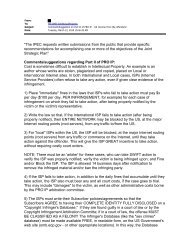We Energies Coal Combustion Products ... - The White House
We Energies Coal Combustion Products ... - The White House
We Energies Coal Combustion Products ... - The White House
Create successful ePaper yourself
Turn your PDF publications into a flip-book with our unique Google optimized e-Paper software.
annual number of curies of each of the major cosmogenic radionuclides<br />
produced in the air over Wisconsin (56,154 square miles) to be as follows:<br />
11.9 Ci of C-14, 552 Ci of H-3, and 15,100 Ci of Be-7.<br />
G. While you may remember NORM as a character from the TV sitcom<br />
“Cheers,” in the field of environmental radioactivity NORM is an acronym for<br />
Naturally Occurring Radioactive Material. <strong>The</strong> air, soil, water, vegetation, and<br />
even our bodies are NORM because they contain varying amounts of<br />
naturally occurring radioactive atoms. <strong>The</strong> most common NORM<br />
radionuclides are uranium, thorium, radium, potassium-40, and carbon-14.<br />
Because of the low radionuclide concentrations in NORM, the unit used to<br />
express these values is the picoCurie or pCi. A pCi is a very small number,<br />
one-trillionth of a curie. As mentioned above, a curie is 2.22 trillion<br />
disintegrations per minute. Hence, one pCi equals 2.22 disintegrations per<br />
minute.<br />
H. <strong>The</strong> standard 70 kilogram (154 pound) adult contains the following amounts<br />
of the aforementioned radionuclides: 30 pCi of uranium, 3 pCi of thorium, 30<br />
pCi of radium, 110,000 pCi of K-40, and 400,000 pCi of C-14 (International<br />
Commission of Radiation Protection – Publication 39 and National Council on<br />
Radiation Protection and Measurements –Report No. 94).<br />
I. Radioactive elements enter our bodies through the food we eat and the air<br />
we breathe. C-14 and K-40 react chemically in the same manner as the<br />
stable or non-radioactive isotopes of these elements and are continually<br />
being incorporated into the plants and animals in the food chain. Because the<br />
chemical composition of our bodies is internally regulated with respect to the<br />
amount of stable carbon and potassium present, the concentrations of C-14<br />
and K-40 are regulated as well. Uranium, thorium, and radium also enter our<br />
bodies through the food chain, but to a lesser extent as evidenced by the pCi<br />
quantities of NORM in our bodies mentioned in the preceding paragraph.<br />
Because radium is chemically similar to calcium, long-lived radium-226 (halflife<br />
= 1600 years) will build up in the skeleton. Uranium and thorium exhibit a<br />
lesser degree of build up. Because of the relative chemical inactivity of Ra,<br />
Th, and U compared to the C and K, it takes a longer time to remove the Ra,<br />
Th, and U once they are incorporated in our bodies.<br />
J. <strong>The</strong> amount of NORM you consume each day depends upon the foods you<br />
eat. Norm has been measured in many food items. Foods high in potassium<br />
have a correspondingly higher amount of K-40. For example, a serving of<br />
dried apricots has 409 pCi of K-40; a fresh banana, 368 pCi; a glass of<br />
orange juice, 409 pCi; bran flakes, 155 pCi; a glass of skim milk, 285 pCi; a<br />
medium potato, 690 pCi; spinach, 97 pCi; substituting lite salt (potassium<br />
chloride) for 1.2 grams of common table salt, 499 pCi; and 3 oz. of chicken<br />
breast, 180 pCi. (If you know the grams of potassium in your food, multiply by<br />
818 to get the number of pCi of K-40). Because the body’s K-40 is chemically<br />
regulated along with non-radioactive potassium, K-40 will not build up in the<br />
body but vary as stable potassium varies as a function of muscle mass and<br />
age.<br />
K. <strong>The</strong> most common mode of radium ingestion is via drinking water. As<br />
recently noted in the Journal-Sentinel, 53 Wisconsin communities will have to<br />
reduce the radium content of their drinking water because it contains more<br />
than the EPA allowable concentration of 5 pCi/liter, (about 19 pCi per gallon).<br />
269 <strong>We</strong> <strong>Energies</strong><br />
<strong>Coal</strong> <strong>Combustion</strong> <strong>Products</strong><br />
Utilization Handbook



